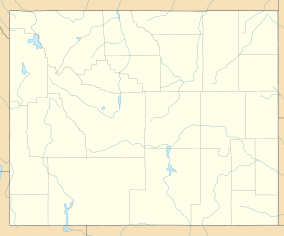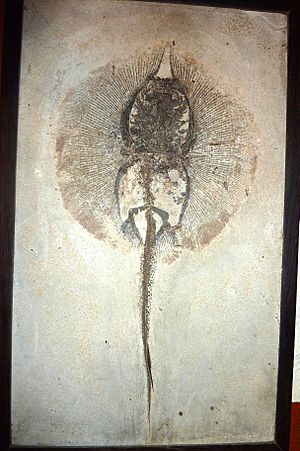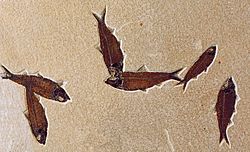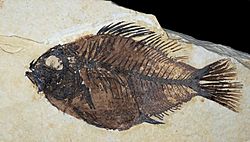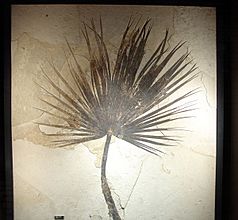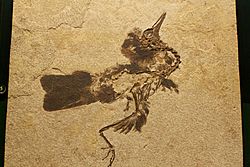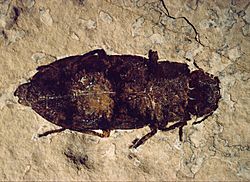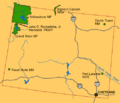Fossil Butte National Monument facts for kids
Quick facts for kids Fossil Butte National Monument |
|
|---|---|
|
IUCN Category V (Protected Landscape/Seascape)
|
|

Fossil Butte National Monument
|
|
| Location | Lincoln County, Wyoming, USA |
| Nearest city | Kemmerer, WY |
| Area | 8,198 acres (33.18 km2) |
| Established | October 23, 1972 |
| Visitors | 16,552 (in 2011) |
| Governing body | National Park Service |
| Website | Fossil Butte National Monument |
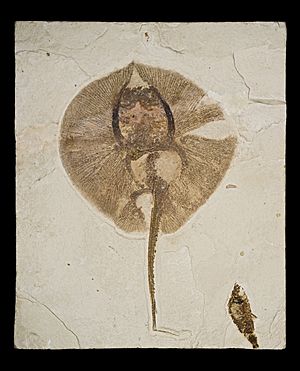
Fossil Butte National Monument is a United States National Monument managed by the National Park Service, located 15 miles (24 km) west of Kemmerer, Wyoming, United States. It centers on an assemblage of Eocene Epoch (56 to 34 million years ago) animal and plant fossils associated with Fossil Lake—the smallest lake of the three great lakes which were then present in what are now Wyoming, Utah, and Colorado. The other two lakes were Lake Gosiute and Lake Uinta. Fossil Butte National Monument was established as a national monument on October 23, 1972.
Fossil Butte National Monument preserves the best paleontological record of Cenozoic aquatic communities in North America and possibly the world, within the 50-million-year-old Green River Formation — the ancient lake bed. Fossils preserved include fish, alligators, bats, turtles, dog-sized horses, insects, and many other species of plants and animals — suggest that the region was a low, subtropical, freshwater basin when the sediments accumulated, over about a 2 million-year period.
Contents
Geologic formations
During the Eocene this portion of Wyoming was a sub-tropical lake ecosystem. The ‘’’Green River Lake System’’’ contained three ancient lakes, Fossil Lake, Lake Gosiute, and Lake Uinta. These lakes covered parts of southwest Wyoming, northeast Utah and northwestern Colorado. Fossil Butte is a remnant of the deposits from Fossil Lake. Fossil Lake was 40 to 50 miles (64 to 80 km) long from north to south and 20 miles (32 km) wide. Over the two million years that it existed, the lake varied in length and width.
Fossil Buttes National Monument contains only 13 square miles (8,198 acres (33,180,000 m2)) of the 900-square-mile (595,200 acres (2.409×109 m2)) ancient lake. The ancient lake sediments that form the primary fossil digs is referred to as the Green River Formation. In addition to this fossil-bearing strata, a large potion of the Wasatch Formation, river and stream sediments, is within the national monument. The Wasatch Formation represents the shoreline ecosystem around the lake and contains fossil teeth and bone fragments of Eocene mammals. Among these are early primates and horses.
History
Coal mining for the railroad led to the settlement of the nearby town of Fossil, Wyoming. When the fossils were discovered, miners dug them up to sell to collectors. In particular, Lee Craig sold fossils from 1897 to 1937. Commercial fossil collecting is not allowed within the National Monument, but numerous quarries on private land nearby continue to produce extraordinary fossil specimens, both for museums and for private collectors.
Exhibits
The Fossil Butte National Monument Visitor Center features over 80 fossils and fossil casts on exhibit, including fish, a crocodile, turtle, bats, birds, insects and plants. A 13-minute video is shown about the fossils found at the site and what scientists have learned. Interactive exhibits let visitors create fossil rubbings to take home, and a computer program discusses fossils, geology and the current natural history of the monument.
Activities
During the summer, lab personnel prepare fossils in public. Summer activities also include ranger programs, hikes, paleontology and geology talks, and participation in fossil quarry collections for the park.
A Junior Ranger program can be completed by children aged 5–12 (with exercises scaled to the child's age) in 3–4 hours. A highlight is hiking 3/4 mile up the butte to the dig, where interns from the Geological Society of America talk about their excavation and let children help them flake apart sedimentary deposits to discover fish fossils and coprolites.
List of fossil species recovered at Fossil Butte National Monument
Fish:
- Asterotrygon, an extinct stingray
- Knightia spp, an extinct fish related to herring and sardines
- Diplomystus spp
- Heliobatis radians, an extinct stingray
- Notogoneus, an extinct bottom-feeding fish
- Crossopholis magnicaudatus (Commons), a 1-meter (40 inches) long predatory paddlefish
Mammals:
- Coryphodon spp
- Onychonycteris finneyi, a bat
- Heptodon spp, an extinct tapir
- Protorohippus sp., an early horse-like mammal
Birds:
Reptiles:
- Afairiguana, an extinct anole
- Bahndwivici, an extinct lizard
- Borealosuchus wilsoni, an extinct crocodile
- Baenidae turtle
Plants:
Primary source:
Gallery
-
Priscacara liops from Fossil Lake. An extinct perch. About 11.5 centimetres (4.5 in) long.
-
An unidentified fossil bird from FBNM, in the collections of the Field Museum
-
A well-preserved Buprestidae beetle (3.5 cm/1.4 in long) from the FBNM collections. Other beetles, flies and Hemiptera bugs have also been found in the Fossil Lake sediments.
Images for kids
-
Map of major Wyoming geological formations, showing Fossil Butte (lower left) far south of Yellowstone (upper left), southwest across the state from Devils Tower (upper right).
-
Priscacara liops from Fossil Lake. An extinct perch. About 11.5 centimetres (4.5 in) long.
-
An unidentified fossil bird from FBNM, in the collections of the Field Museum
-
A well-preserved Buprestidae beetle (3.5 cm or 1.4 in long) from the FBNM collections. Other beetles, flies and Hemiptera bugs have also been found in the Fossil Lake sediments.


